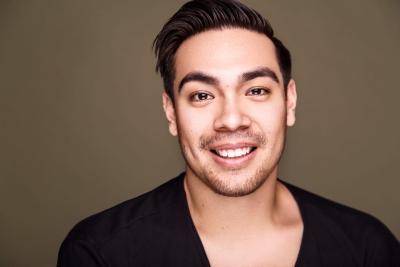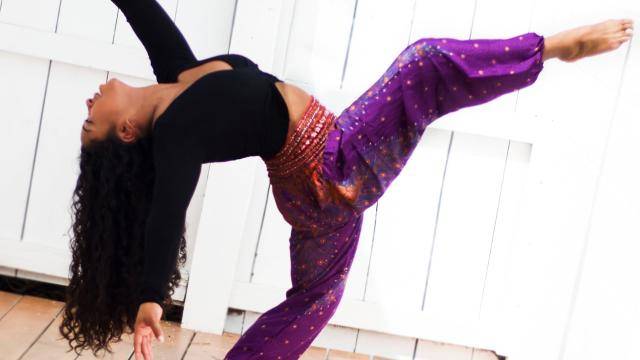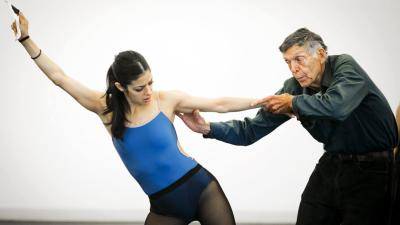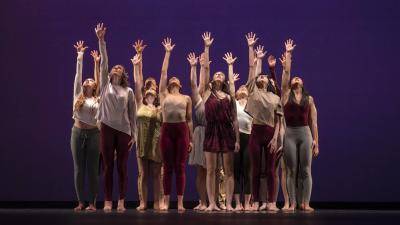San Diego is known for being a cultural hub with major museums, loads of tourism, and two theaters that are incubators for Broadway’s next hits. One would think that because of this, living as an artist in the area would provide a mecca of opportunities; That the caliber of training and companies would make it similar to any of the other major cities that consider themselves an arts hub. However, after speaking with two local San Diego artists, it seems that there are many struggles rooted in systemic racism that come with being a full-time BIPOC performer and creator.
Two dancers have seen the problems, both in racial inequities and in being a local artist, in San Diego over their tenure there and have begun to actively work towards creating systemic changes for themselves and future generations. The first artist who is working to make a difference within this arts hub is Alyssa Junious. Her dance company Continuum, started in 2017, out of her necessity to feel creatively fulfilled and to change the views on how dance companies work in San Diego. To Junious, a dance company isn’t about honoring just one artistic director’s vision, or choreographer’s vision. “I value collaboration,” Junious says, “it’s about amplifying the stories of the artists I choose to create art with.”

Junious also had come to think of her choreography and dance as a form of protest long before the national conversation tuned into the Black Lives Matter movement. As a self-proclaimed contemporary fusion artist she feels that “it is a protest because I am a black artist. Just existing in the space, because it is not a part of the system for us to be at the top. Me being an artist shows that my story, my lens, is just as important as anyone else’s. I would like to just exist. For my work to not need to be about being Black or Filipina. I would like my work to be about an experience I want to share, but right now we are using labels as a language of protest.” Junious also opens up her process as a way of showing the world what it takes to be an artist and an artist of color in San Diego. She wants her audience to be a part of the conversation. Through Continuum she hopes to “create a bridge, or portal, or continuum to bring theater, museums, and dance together in immersive audience experiences”
Modern and contemporary forms of dance aren’t often considered on the same level of high art as painting, sculpture, or other visual art forms. “There is a hierarchy of elitism, where performing artists are secondary. My work, in creating art as a conversation, is a way to start a trend where live art is the main attraction.” Junious is creating pieces specifically for museums as a way to parallel her work to those on top of this hierarchy. By taking up space in museums and allowing viewers to watch the process of creation, she feels that it was also another form of protest: existing in a place you aren’t usually invited into.
"I use my work to bring attention to intention." - Alyssa Junious
While Junious stands strongly by her vision of what dance in San Diego could be and how she hopes to continue to create change, the biggest issue she faces is funding: a problem BIPOC artists all over the country have talked about as a direct result of the systemic racism that exists in the arts. Statistically, there are less BIPOC artists in leadership roles in the committees that control grant funding. Junious has faced this head on as an independent artist and not a non-for-profit, where grants and commissions are even harder to come by. There is a lack of dance organizations that offer commissions to local choreographers, even if they host competitions for up-and-coming artists. Rather than be deterred by money problems for creating, she has found a few ways to persist as an independent artist and sustainability is definitely her long game in which she aims to facilitate lasting change in the San Diego arts scene.
Junious plans on getting her Arts Management Certificate and next year will be joining USD’s Rising Arts Leaders Fellowship. From those two programs Junious can become more of a “community entity that could allow [her] to explore options to become a non-for profit [eventually] and create more partnerships to be fiscally sponsored.” Figuring out grant writing has helped Junious lock down funding to support company growth. The William Male foundation awards grants support to independent artists and that allowed her to break into San Diego’s Musical Theater scene by funding her acting and singing coaching for a year. Since becoming a grant recipient, she now sits on the selection board and helps as a voice for who receives next year’s grants. “I’m very proud of that because our grant selection committee is diverse in our representation. I am able to help others who look like me, get the opportunity to be independently funded.”
As a bi-racial artist Junious has experienced the hardships brought on by the systemic racism of theater and dance institutions. By shining the spotlight on inequalities that all artists of color have faced, Junious feels that the Black Lives Matter movement has given her, her company, and body of work the attention she wasn’t able to get before. “I’ve been doing this work for years, since 2015, but it has given me visibility and hashtags. With this movement I am able to amplify my voice and more people are interested in working with me. I am now being regarded as a choreographer, as an artist. I’m able to keep protesting by plugging myself into spaces that normally wouldn’t have me. As a black artist, I matter. There is a lot of intersectionality in me being a Black woman and an artist in San Diego. Not all are welcomed to work with me but I appreciate the intent [Junious, like all BIPOC artists, must sort through who is genuinely interested in her work long-term versus who is currently attempting to tokenize her and use her as a way to save face.] And I’m ready to be commissioned. I have done the work and I’ve been making and creating moves for change so, as a company, I am so ready to house opportunities for other artists and really foster that communal arts community that I wanna see in the future. I want the SD dance community to be a place where diversity, inclusion, and equity are a real thing. That requires more collaborations and to combine resources. My work has always been protesting to be heard. Feeling like I had been tokenized, I empathize [with anyone] who has felt used, being a vessel for [someone else’s] personal gain. I use my work to bring attention to intention.”
Activism and protest without action is performative. Junious is using her art truly as a starting point for that action to be sparked. “Art disarms us. It allows us to come to a collective space to connect and heal, reflect, release, process, and then have action. Paired with questions, I share prompts that I use to create the work so that I can share my truth but also to allow others to connect and be more active. It is not for you to passively enjoy. It is to actively engage not only myself, or the artists performing but also the audience. That’s what makes my work activism. I am immersing you in the work; I am working to engage you so that you can take action within your own life [and] advocate for yourself [where] you have the agency and [empowerment] to reflect that in your life.”

The second artist spotlighted is Julio Cataño-Yee. He brought up two separate but interconnected issues that he and his company Teatro San Diego hopes to address. The first comes from his struggles as a local actor. Cataño-Yee left San Diego in 2007, has been back and forth since 2015 for stints, but was primarily based in NY until he made the decision to return to grad school in San Diego this year. When he came back to San Diego, where he had grown up but not worked professionally, he discovered that the theaters there hired more often out of New York and didn’t use local actors for union contracts; if they did, most often it was for swing contracts that weren’t always well designed for his success. In one instance, a production of Kiss My Aztec had him start learning the show once it was in previews -- which is not common practice. These theaters “with the highest gross receipts and a Tony award” are known not to “cast [local artists] in productions they intend to send to New York. I think what really hurts the local actor is that they can’t make a living out of acting in San Diego. It’s not a livable wage in comparison to cities like Washington DC or Chicago, which invest in including the performing arts in their economic development.” He has been diligent in his research of budget spending on the arts to try and understand how to change the scene of SD. “DC and Chicago create jobs and economy in theater, in San Diego a $3000 stipend or $400 weekly salary is sought after. So when an actor has the opportunity to join the Actor’s union they must either decline because of the eventuality of working less frequently, or leave the city unless they are favored by some particular theater company. Theaters that frequently hire local San Diegans only give union contracts to select principle roles, further solidifying the lesser worth of the ensemble.” On a union contract there are minimums that an actor can be paid on any given contract ensuring a livable wage, housing, transportation. As a non-union artist, none of that is guaranteed making becoming a local artist outside of other major cities less sustainable. “I spent thousands of dollars, as we all do, on a college degree, thousands of dollars on my fierce voice, as we all do, and a few more on this masters, so that I could be another ensemble person. After doing it on tours and in NY for a few years I thought, ‘maybe I can come home and just work in San Diego.’ I was proven wrong.”
The second issue that became clear to Cataño-Yee within the local hires was a disparity in working BIPOC performers because of a systemically rooted lack of opportunity. “[All] the actors I’ve been fortunate to work with so far have expressed unanimously that when a San Diego professional actor of color auditions at local auditions for theaters that produce musicals, they find themselves competing for one or two spots [union or not] that represent all the people of color in that world. They find this disparity mostly in the Christmas shows. Our research (hard research on census.gov) finds San Diego is 45% white alone, not Hispanic or Latino. There’s a disparity in accurate representation of San Diegans in more than just theatre.” By also not designating whether these two BIPOC tracks should be equity or not means that more often than not the locals are non-union; they are working for less money and benefits perpetuating this racist cycle, which prevents these artists from supporting themselves fully through a performing career.
As a community, if we aren’t pulling each other up on our own journeys to success I don’t think we are truly being well-rounded, ethical artists.
Cataño-Yee was curious as to why there also seemed to be a lack of BIPOC performers and opportunity for them, unless they are doing a race-based show, like West Side Story, in a city known as an arts capitol. Through his research he has unsurprisingly discovered that systemic racism has a hand in the way the city has been designed, there are financial and racial divides that affect access to training. “I still have an active real estate license in the state of New York, it was drilled into us how the Fair Housing Act of 1968 was created to stop redlining. In San Diego, we know what a home is priced in La Jolla, Del Mar, Solana Beach etc. and what a house in Encanto, Valencia Park, Spring Valley, City Heights is, this all results in where we ended up in 1968. Our neighborhoods that don’t get the high property tax which funds schools, don’t get allocated the resources needed to fund arts programs, certain special education therapies, support that facilitates student graduation and admittance into higher education. The student body south of Interstate 8 often needs further support with situations at home that are very different from neighborhoods north of the Interstate 8. Much of our southern neighborhoods have children crossing the international border at 4am to get to school by 6am and are very tired and must sleep during school hours. This is just one aspect that people don’t know of our city that I feel must become common knowledge. Theatre is the last thing someone thinks about if they’re deprived of sleep or are a child who forgot their pencil at home because police were knocking on their door at 5am due to a fight. Parents, for the most part in my specific culture, do not see theatre as a career choice and NEED a “steadier” career choice for their children. They miss the opportunity of arts working as a therapy for communication, self-management, social-awareness, elements that can solve these problems we see in our community.”
Cataño-Yee saw all of this, and thought, something has to systematically change. There is not a single theater below the I-8 that operates with over a million dollar budget. There isn’t a unionized dance company in San Diego at all, and no dance company in South County that operates over a quarter million dollar budget. “I’m going to change this.” He and his partners have created Teatro San Diego, brilliantly tag lined “Defining All American.” It was created recently during the Covid stay-at-home orders and has three major components.

The first is to do one show a year that shows the equitable split of parts between all races based on the San Diego Census and the company will continue to monitor that census and adjust appropriately for every show. They will continue to cast and search for talent until those quotas are met. It will be about holding true to reflective representation that will make this an all American theater company.
The second component is education. The company wants to make theater and dance accessible to those who don’t normally get access to training for it. Cataño-Yee is also passionate about it being more than simply hiring dance teachers or vocal coaches and sending them into middle schools for after-school programs. South County has a ton of after-school programs that go until around 6pm because of parents needing extra child care. This is the time he wants to place the education in. He also aims to focus on the kids who are having trouble in school and have teachers who are trained and prepared to work in these kinds of environments; trained to guide students with the trauma they may hold and still be able to give competitive programming that resembles a conservatory-style program.
The third component is in dance. There seems to be a lot of politics in the dance scene in San Diego. Shockingly there is no union dance company at all. Most major cities have an AGMA dance company, and some of these cities are smaller than San Diego. According to Cataño-Yee and the surveys he and his team have sent out to local dancers and actors, the talent in San Diego isn’t up to par for choreographers to hire these dancers. There are 5 dance companies that run with a budget over ¼ million. None of these have a person of color as an artistic director. Also, all the artistic directors of the companies are the main choreographer. There are almost no opportunities for local choreographers of color to gain access to create and set work on these company members. Most self-run companies in SD are running on a 2k dollar budget a year. Dancers shouldn’t have to dance for free and choreographers shouldn’t have to ask dancers to do so. This third component of Cataño-Yee’s theater company will take San Diego choreographers once a year to New York and provide them with an ensemble of diverse dancers to work with and produce a show in New York. It will bring the San Diego choreographer’s point of view to a New York audience with talent that can fully realize the intended vision.
Art disarms us. It allows us to come to a collective space to connect and heal, reflect, release, process, and then have action.
These are huge goals and what's absolutely incredible is that Cataño-Yee and his team are funding it all themselves. “We will not ask for donations until we have a tax-exempt status.” Who are these rock stars starting the first steps in changing the face of San Diego theater? “Teatro San Diego at the moment has a Theatre Council and a Dance Council. It is a group of professional actors from Broadway and New York mixed with the same amount of local San Diegan actors of Black, Asian, and Latinx descent. We understand we have a lot of work to do to make it truly diverse and representative right now especially with the Kumeyaay Nation.” The Kumeyaay Nation is the tribe of people indigenous to the border of Mexico and California. “Our Dance Council is primarily comprised of both choreographers and company dancers from the Alvin Ailey Company, Sidra Bell Dance, and Ballet Hispanico to local San Diego talent including 3 San Diego Young Choreographers Prize winners who have never been invited to set repertoire on the 5 major dance companies in San Diego.”
Both Junious and Cataño-Yee are incredible artists for taking action to cure the injustices they themselves have faced as artists in the business and make opportunities for others. As a community, if we aren’t pulling each other up on our own journeys to success I don’t think we are truly being well-rounded, ethical artists. There is always some way to help make this tough industry better for everyone. Hats off to Julio Cataño-Yee and Alyssa Junious for doing it full out and using their incredible talents for the greater good. If they are inspiring you and you would like to see more of what they are doing, check out Teatro San Diego for Julio’s company and for Alyssa’s work, here is a link to her Continuum’s sizzle reel and a piece called 2426 Walcott Lane she created while a dancer for the company PGK.




